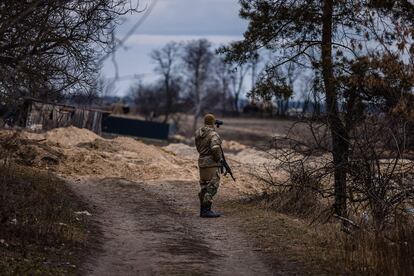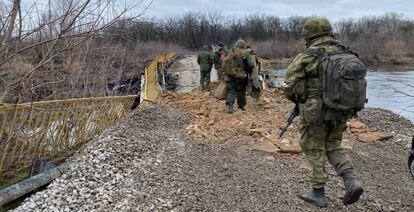US intelligence did not prevent Russia’s invasion of Ukraine, but it brought Western bloc together
Accurate information shared with Kyiv and European allies gave time to coordinate sanctions and send reinforcement troops to NATO member countries in the east

Six days elapsed from the time that US president Joe Biden said he believed Vladimir Putin had already made the decision to invade Ukraine, on February 18, until the Russian offensive became effective in the early hours of February 24. The Biden administration had been warning for weeks that the Russian president had made all the necessary preparations for the attack. Intelligence services had collected and shared detailed, real-time information on the movement of Russian troops across the border. They were also familiar with the Kremlin’s plan to fabricate an excuse in the form of a “false flag” attack to justify its incursion into Ukraine.
US intelligence removed the surprise factor from the equation. It helped prepare the synchronized wave of sanctions against the Kremlin and facilitated the evacuation of US citizens in Ukraine. It also played a role in the deployment of reinforcement troops to NATO member countries in Eastern Europe and, ultimately, helped shape public opinion, which is unanimous in its condemnation of the war.
Almost two decades after the controversial invasion of Iraq with the never proven argument of the existence of weapons of mass destruction, US intelligence services have now scored a victory, even if it is one without any redeeming role and which has not prevented the attack: Putin is already laying siege to the Ukrainian capital, Kyiv, unfazed by the civilian casualties. But US intelligence has helped bring allies together against the Kremlin’s threat, and has provided the time to develop an unprecedented and coordinated program of sanctions on multiple fronts. However, none of this has helped stop what appears to be the biggest risk of a world war of the last 80 years.

“The quality of US espionage is beyond our reach, they have infiltrated every corner of Moscow, and it is clear that they sincerely fear that something might happen,” a top European official in Washington told this newspaper in early February. At that time, European authorities were still using a very different tone from their US counterparts. While Americans were considering the withdrawal of diplomats from Ukraine, their partners in Europe were saying there were no sufficient grounds to do so. While Washington was exposing the arsenal of sanctions it was willing to apply, Brussels was hiding its cards.
In any case, at that time Washington was not yet certain that Moscow had made the decision to invade; but it was sure that Putin had a perfectly designed plan, and that he wanted to do so. On January 28, Pentagon officials warned that Russia had full military capability to invade the entire country, with an estimated 130,000 soldiers on the Ukrainian border – a figure unseen since the days of the Cold War. “There are multiple options available to [Putin],” said Defense Secretary Lloyd Austin. “Including the seizure of cities and significant territories” as well as “provocative political acts like the recognition of breakaway territories.”
The Ukrainian president himself, Volodymir Zelenskiy, warned the West against spreading “alarmist” messages about an imminent attack, which, added to Russia’s continuous denials, contributed to the creation of doubt about the veracity of the information handled by the allies. Time has cleared up these suspicions in an atrocious way.

On February 21, Putin recognized the sovereignty of the pro-Russian territories of Donetsk and Luhansk as two new independent republics and ordered the first Russian soldiers to cross the border to “maintain peace” and protect the population there, which the Kremlin portrayed as victims of “genocide” by Kyiv. Putin condemned terrorist attacks in the area. Barely 48 hours later, in the middle of a United Nations Security Council meeting in New York (before dawn on February 24 in Ukraine), the Russian president declared war on Ukraine under the euphemism of a “special military operation.”
The first warnings that such a thing could happen had reached the White House in October through secret meetings of the national security team. The mess of the US troop withdrawal from Afghanistan was very recent, as was the conflict arising from the military agreement on submarine development signed with the United Kingdom and Australia without informing European allies. Biden then tried to contain European suspicions, and chose to share the intelligence findings with his partners across the Atlantic (Germany and other EU states that are highly dependent on Russian gas took the information and acted accordingly); and with the public opinion afterwards. After that, he reinforced the amount of US aid to Ukraine.
Always one step ahead of the Kremlin, US intelligence services have also had to deal with disinformation, a fundamental component of hybrid warfare, topped by a more traditional one: sabotage operations. In late January, Washington warned that Russia was planning a “false flag” attack against its forces in eastern Ukraine as an excuse to invade the former Soviet republic. One month later, Moscow resorted to alleged terrorist acts in Donetsk and Luhansk to justify the “special military operation” that has driven the world to the brink of the abyss. The Kremlin continues to use the sabotage decoy as a disinformation tool: the fire at the Zaporizhzhia nuclear power plant on Friday was caused by “Ukrainian sabotage” to divert the blame to Moscow, according to the Russian ambassador to the UN. Satellite data has refuted this claim.
The accuracy of US intelligence on this matter is due to a conjunction of elements: a rebuilt information network on the ground in Russia; government and commercial satellites –such as those from Colorado-based Maxar Technologies– tracking troop movements; the improved capability to intercept communications, and even open-source material culled from Russian social media.
According to The New York Times, improvements in cryptology and electronic-intercept technology over the past decade, added to a growing global reliance on computer networks and mobile communications have reinforced the amount of available resources. Even though Vladimir Putin avoids the use of electronic devices, his soldiers carry unsecured cellphones in their pockets, multiplying data collection targets.
Democrat and Republican lawmakers have recently considered the accuracy of the forecasts a well-deserved endorsement of the intelligence community, which had been criticized for the fiascos in Afghanistan or, in 2003, for Saddam Hussein’s alleged arsenal of weapons of mass destruction.
In the US, some argue that Washington and Kyiv could have done more with such plentiful intelligence, which the Biden administration shared with Zelenskiy’s despite certain initial reservations. The White House shared its intelligence with Ukraine even before Russia began amassing troops last year, and accelerated the exchange of information during the crisis. The American government lifted its usual restrictions to share its findings with Ukrainians, and later with the allies.
Even so, the United States and Ukraine have often disagreed in public and in private about the nature and extent of the Russian threat, as well as the actions to be taken. Zelenskiy did not mobilize reservists until February 23, on the eve of the invasion, when he decreed a 30-day state of emergency.
Tu suscripción se está usando en otro dispositivo
¿Quieres añadir otro usuario a tu suscripción?
Si continúas leyendo en este dispositivo, no se podrá leer en el otro.
FlechaTu suscripción se está usando en otro dispositivo y solo puedes acceder a EL PAÍS desde un dispositivo a la vez.
Si quieres compartir tu cuenta, cambia tu suscripción a la modalidad Premium, así podrás añadir otro usuario. Cada uno accederá con su propia cuenta de email, lo que os permitirá personalizar vuestra experiencia en EL PAÍS.
¿Tienes una suscripción de empresa? Accede aquí para contratar más cuentas.
En el caso de no saber quién está usando tu cuenta, te recomendamos cambiar tu contraseña aquí.
Si decides continuar compartiendo tu cuenta, este mensaje se mostrará en tu dispositivo y en el de la otra persona que está usando tu cuenta de forma indefinida, afectando a tu experiencia de lectura. Puedes consultar aquí los términos y condiciones de la suscripción digital.
More information
Últimas noticias
Most viewed
- Sinaloa Cartel war is taking its toll on Los Chapitos
- Oona Chaplin: ‘I told James Cameron that I was living in a treehouse and starting a permaculture project with a friend’
- Reinhard Genzel, Nobel laureate in physics: ‘One-minute videos will never give you the truth’
- Why the price of coffee has skyrocketed: from Brazilian plantations to specialty coffee houses
- Silver prices are going crazy: This is what’s fueling the rally










































